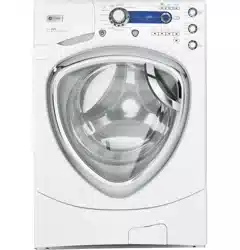Documents: Go to download!
User Manual
- User Manual - (English, French, Spanish)
- Quick Specs - (English)
- Energy Guide - (English)
- Operating Instructions
- Troubleshooting
Table of contents
User Guide Washer
Operating Instructions
About the washer control panel.
You can locate your model number on a label on the side of the washer.
WARNING! To reduce the risk of fire, electric shock, or injury to persons, read the IMPORTANT SAFETY INSTRUCTIONS before operating this appliance.
Quick Start
If the screen is dark, press the POWER button to “wake up” the display.
- Press the POWER button.
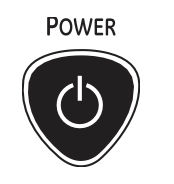
- Select a wash cycle or Steam Refresh cycle. (Defaults are set for each cycle. These default settings can be changed. See Control settings for more information.)
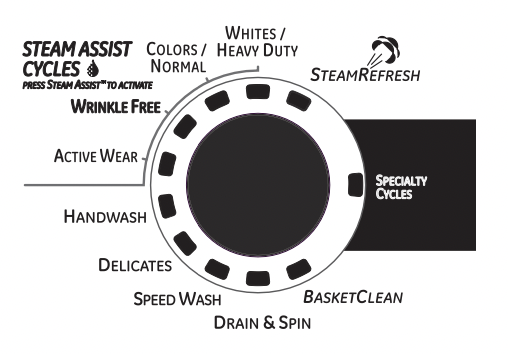
- If you selected a cycle other than the SPECIALTY CYCLE, press the START/PAUSE button.

If you selected SPECIALTY CYCLE, choose between Rinse and Spin, Garments, Bed and Bath, and Other Specialty for your specific needs before pressing START/PAUSE. See specialty cycles for more information."
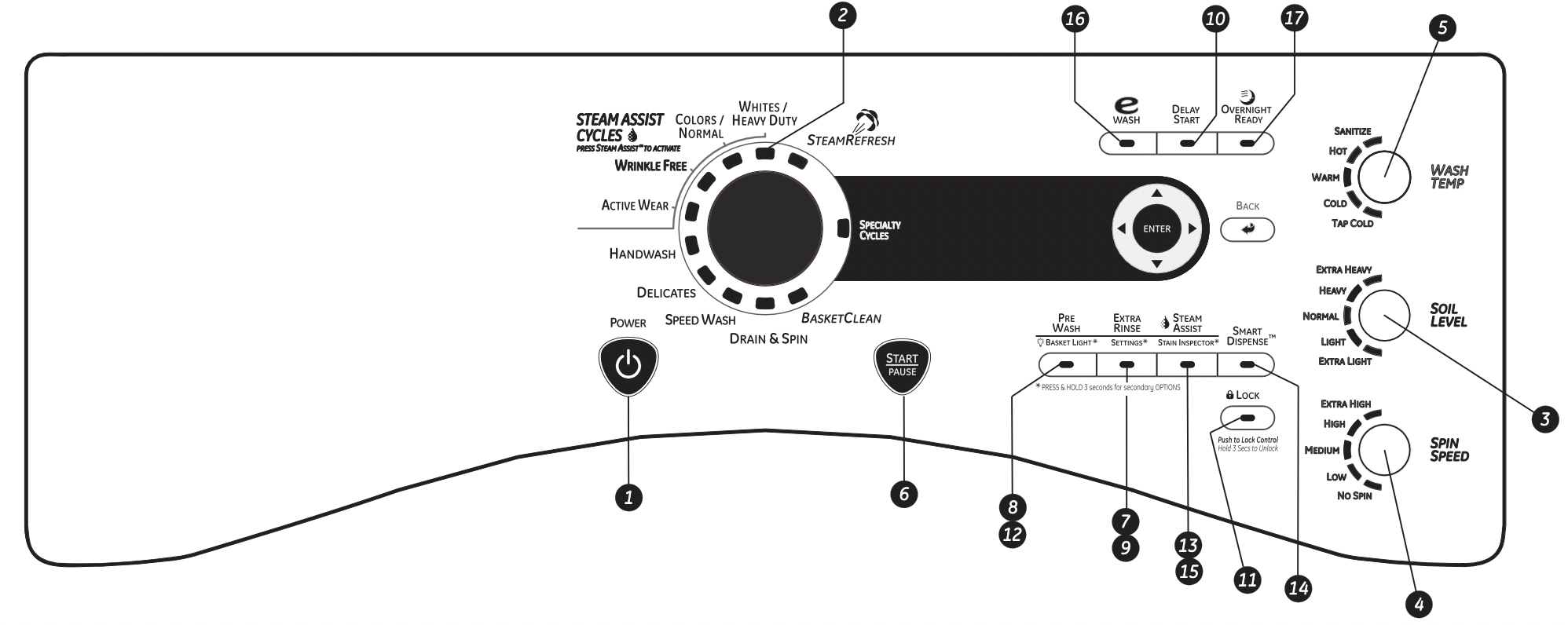
- Power
Press to “wake up” the display. If the display is active, press to put the washer into standby mode. NOTE: Pressing POWER does not disconnect the appliance from the power supply. - Wash Cycles
The wash cycles are optimized for specific types of wash loads. The chart below will help you match the wash setting with the loads. The GentleClean ™ lifters lightly tumble the clothes into the water and detergent solution to clean the load.
See other models: JBP23DR1BB JB625GK2SA PVM9215SK3SS PSHS6RGXBDSS JBP24BB4WH

Specialty Cycles
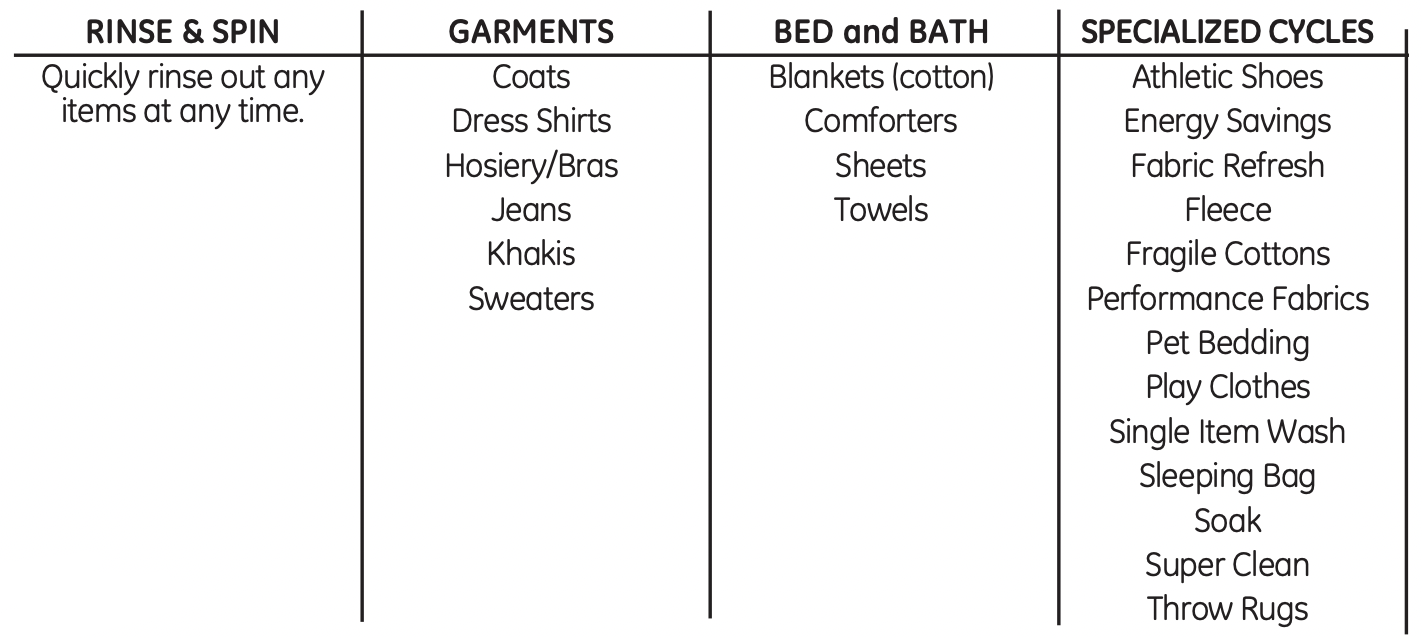
While in the Specialty Cycle, use the and
and  arrow keys to scroll between the different options. Press ENTER to select the cycle. Press BACK to go to the previous menu.
arrow keys to scroll between the different options. Press ENTER to select the cycle. Press BACK to go to the previous menu.
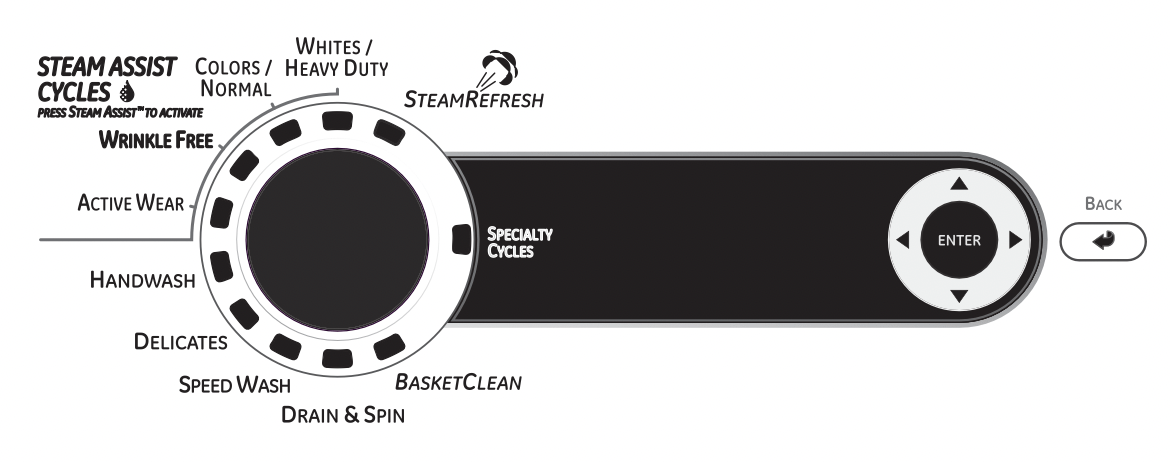
- Soil Level
Changing the SOIL LEVEL increases or decreases the wash time to remove different amounts of soil.
To change the SOIL LEVEL, press the SOIL LEVEL button until you have reached the desired setting. You can choose between Extra Light, Light, Normal, Heavy or Extra Heavy soil. - Spin Speed
Changing the SPIN SPEED changes the final spin speed of the cycles. Always follow the garment manufacturer’s care label when changing the SPIN SPEED.
To change the SPIN SPEED, press the SPIN SPEED button until you have reached the desired setting. You can choose between No Spin, Low, Medium, High or Extra High Spin. Higher spin speeds are not available on certain cycles, such as Delicates.
Higher spin speeds remove more water from the clothes and will help reduce dry time, but may also increase the possibility of setting wrinkles on some fabrics. - Wash Temp
Adjust to select the proper water temperature for the wash cycle. The prewash and rinse water is always cold to help reduce energy usage and reduce setting of stains and wrinkles.
Follow the fabric manufacturer’s care label when selecting the wash temperature.
To change the wash temperature, press the WASH TEMP button until you have reached the desired setting. You can choose between Tap Cold, Cold, Warm, Hot or Sanitize. The Sanitized wash temperature is not available on certain cycles, such as Delicates.
When selecting the Sanitize wash temperature, the washer increases the water temperature to sanitize and kill more than 99% of many common bacteria found in home laundry. The sanitize wash temperature is only available on the Whites/Heavy Duty wash cycle. For best results, select the heavy soil setting when using the Sanitize wash temperature setting.
NOTE: The first 10 seconds of the wash fill is always cold. This feature assists in conditioning the fabric and preventing stains from setting on garments. - START/PAUSE
Press to start a wash cycle. If the washer is running, pressing it once will pause the washer and unlock the door. It will take a few seconds for the door to unlock after pressing PAUSE. Press again to restart the wash cycle.
NOTE: If the washer is paused and the cycle is not restarted within 15 minutes, the current wash cycle will be cancelled.
NOTE: In some cycles the washer will drain first, then unlock the door when it is paused.
NOTE: The washer performs automatic system checks after pressing the START button. Water will flow in 45 seconds or less. You may hear the door lock and unlock before water flows; this is normal. - Settings
Press & hold for 3 seconds for SETTINGS. Use the SETTINGS button to adjust the following features:
Dryer Link:
Press the SETTINGS button. When “DRYER LINK” appears in the display, press ENTER. Using the arrow keys, select ON and press ENTER.
arrow keys, select ON and press ENTER.
When the washer cycle is completed, the washer will communicate with the dryer when any button on the control panel is touched or the door is opened.
The washer will display, “TRANSFERRING CYCLE INFORMATION TO THE DRYER” and the dryer will display, “RECEIVING CYCLE INFORMATION TO THE DRYER”.
The dryer will only communicate with the washer if the dryer is not running a cycle.
If the washer starts a new cycle before the dryer has a chance to communicate with it, the information will be lost.
End-of-Cycle Volume:
Press the SETTINGS button. When “VOLUME” appears in the display, press ENTER, then select “End of Cycle”. Using the arrow keys, select High, Medium, Low or Off.
arrow keys, select High, Medium, Low or Off.
Control Sounds:
Press the SETTINGS button, then select “Volume”. When “CONTROL SOUNDS” appears in the display, press ENTER. Using the arrow keys, select High, Medium, Low or Off.
arrow keys, select High, Medium, Low or Off.
Display Brightness:
Press the SETTINGS button. When “DISPLAY BRIGHTNESS” appears in the display, press ENTER. Using the arrow keys, select High, Medium or Low.
arrow keys, select High, Medium or Low.
Water Hardness (Selectable only when SMART DISPENSER Pedestal Accessory is connected to washer):
This will adjust the amount of detergent dispensed automatically for the SMART DISPENSER. See the Owner’s Manual supplied with the SMART DISPENSER for instructions for use.

- Prewash
Prewash is an extra wash before the main wash. Use it for heavily soiled clothes or for clothes with a care label that recommends prewashing before washing. Be sure to add high-efficiency detergent, or the proper wash additive to the prewash dispenser.
The prewash feature will fill the washer (adding the prewash detergent), tumble the clothes, drain and spin. Then the washer will run the selected wash cycle.
NOTE: In some special cycles, the prewash is selected automatically as the default. You can modify this selection at any time.
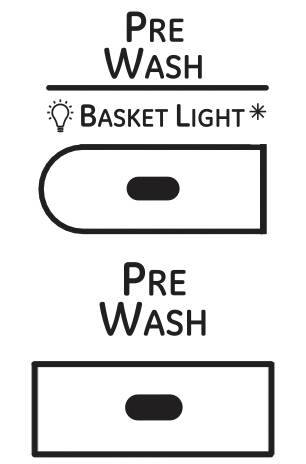
- Extra Rinse
Use an extra rinse when additional rinsing is desired to remove excess dirt and detergent from soiled loads.
NOTE: In some special cycles, the extra rinse is selected automatically as the default. You can modify this selection at any time. Some cycles have additional rinses done automatically.
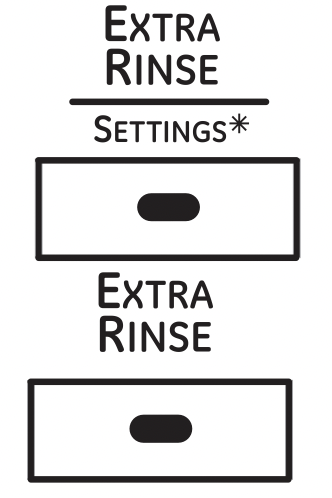
- Delay Start
You can delay the start of a wash cycle for up to 24 hours. Press the DELAY START button to choose the number of hours you want to delay the start of the cycle. Use the and
and  (up and down) arrows to find the desired delay time; then press ENTER to select the delay time. Finally, press the START button after the desired cycle is selected. The machine will count down and start automatically at the correct time.
(up and down) arrows to find the desired delay time; then press ENTER to select the delay time. Finally, press the START button after the desired cycle is selected. The machine will count down and start automatically at the correct time.
NOTE: If you forget to fully close the door, a reminder signal will beep reminding you to do so.
NOTE: If you open the door when the delay is counting down, the machine will enter the pause state. You must close the door and press START again in order to restart the countdown.

- Lock
You can lock the controls to prevent any selections from being made. Or you can lock or unlock the controls after you have started a cycle.
Children cannot accidentally start the washer by touching pads with this option selected. To lock the washer, press and hold the LOCK button for 3 seconds. To unlock the washer controls, press and hold the LOCK button for 3 seconds. A sound is made to indicate the lock/unlock status.
The control lock icon on the display will light up when it is on.
NOTE: The POWER button can still be used when the machine is locked.
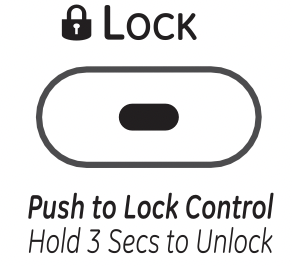
- BASKET LIGHT
The basket light will turn on and remain on for 5 minutes when the door opens, start/pause button is pressed, or by pressing and holding the basket light button for 3 seconds. The basket light can be turned off by pressing and holding the basket light button for 3 seconds. The basket light can not be turned off while the unit is idle.
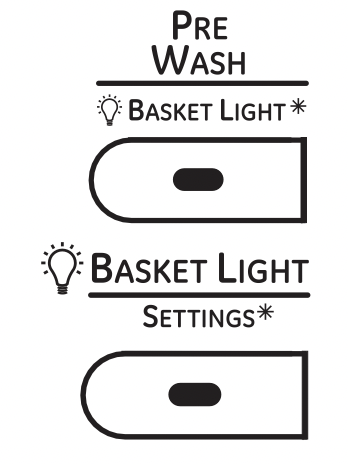
- Stain Inspector
PFWS4600, 4605 Press & hold for 3 seconds for STAIN INSPECTOR.
The STAIN INSPECTOR feature allows you to indicate what stains are on the garments in your load. This feature can be used with any wash cycle.
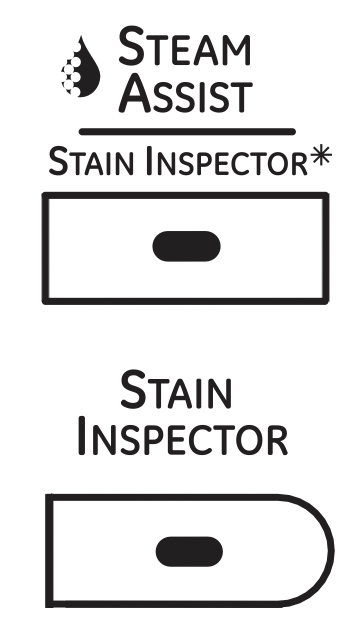
To use STAIN INSPECTOR:
1. Select the wash cycle.
2. Press the STAIN INSPECTOR button (the button will light up when it is on).
3. Check the wash instructions on your garment.
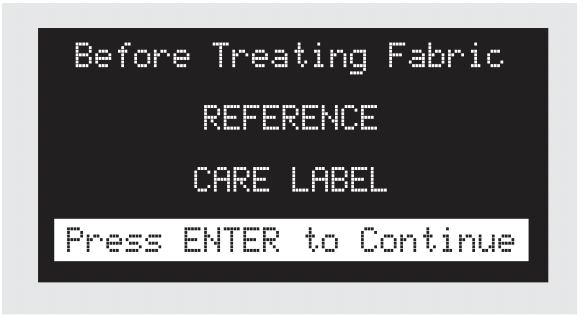
4. Press the ENTER button to continue.
5. Use the and
and  arrows to find the desired stain category.
arrows to find the desired stain category.
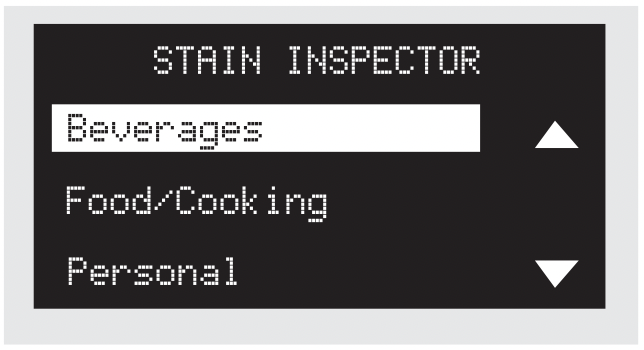
6. Press the ENTER button to select the stain category.
7. Use the and
and  arrows to select the desired stain.
arrows to select the desired stain.
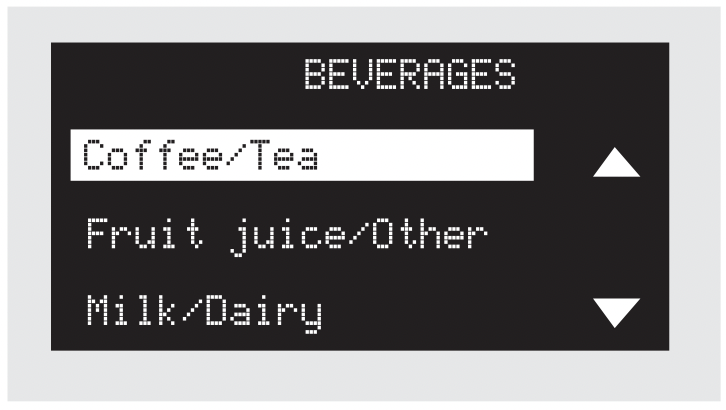
You have the following stains available to choose from:
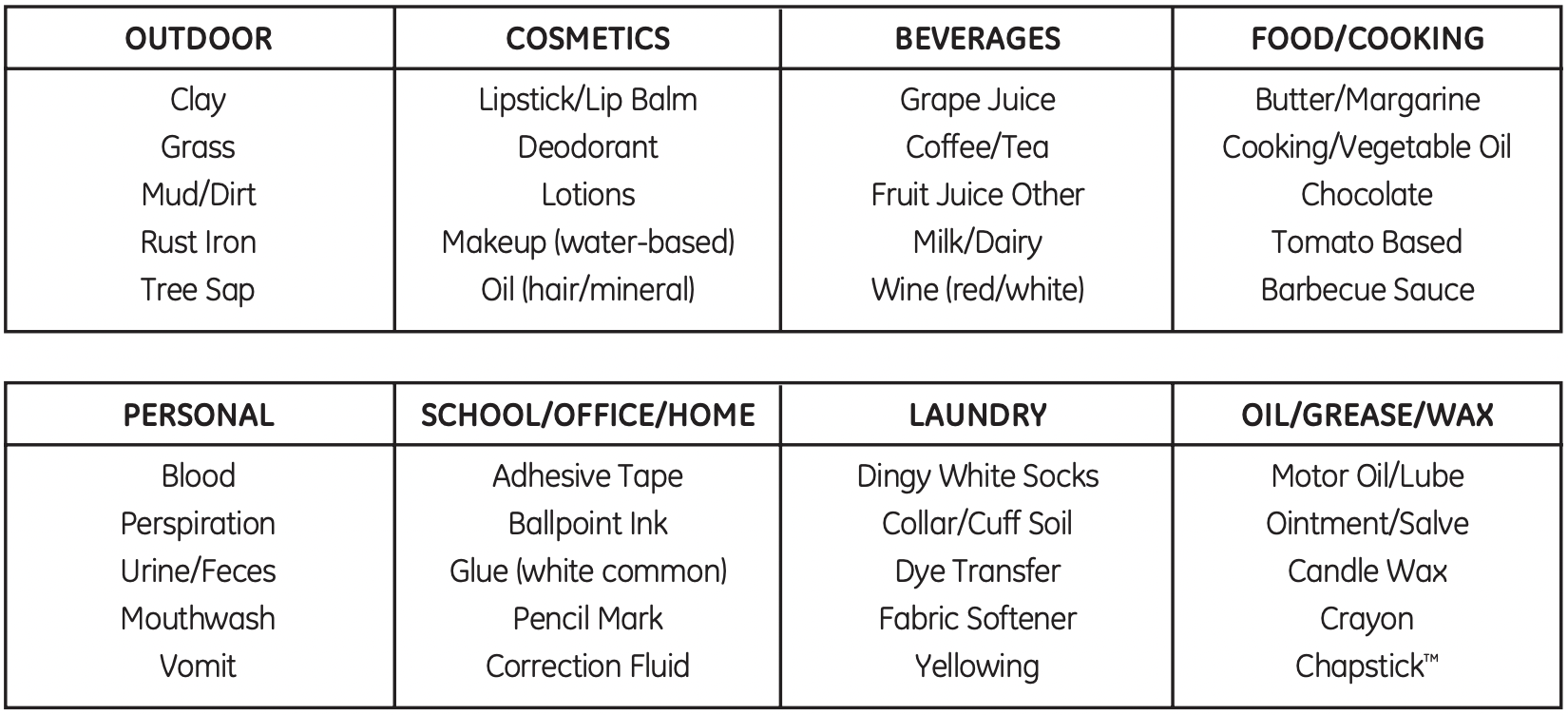
8. Press the ENTER button to select the stain.
9. Your selected stain will appear on the display.
10. Press the START button to start the cycle.
NOTE: To turn off STAIN INSPECTOR or to select a different stain, press the STAIN INSPECTOR button again.
NOTE: Prewash is selected automatically as the default for some stains. When selected automatically, the PREWASH button will light. For optimum stain removal, it is recommended to add high-efficiency detergent or proper wash additive to the prewash dispenser. You can turn off the prewash option if you do not want to add the prewash to the cycle. - SMART DISPENSE ™ – optional accessory (on some models)
If you have purchased the PROFILE SMART DISPENSE System, refer to the Owner’s Manual that comes with the SMART DISPENSE System.
If you have not purchased the PROFILE SMART DISPENSE System, you will not have bulk-dispensing capability. If you select the SMART DISPENSE option, a message will be displayed advising that your unit does not have the capability. You should then put detergent and other selected additive in the flow-through dispenser drawer located at the top left of the unit.
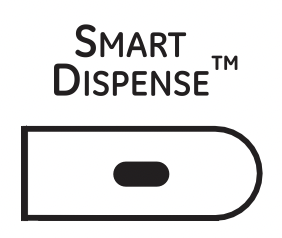
- STEAM ASSIST (on some models)
STEAM ASSIST adds steam into the washer during WHITES/HEAVY DUTY, COLORS/NORMAL, WRINKLE FREE or ACTIVE WEAR cycles.
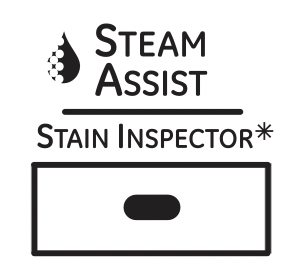
To use:
1. Turn power ON and select a wash cycle. The STEAM ASSIST option is only available on WHITES/HEAVY DUTY, COLORS/NORMAL, WRINKLE FREE or ACTIVE WEAR cycles.
2. Select the STEAM ASSIST button to activate Steam.
3. Press the START/PAUSE button. - ENERGY SAVINGS WASH
Use "e" WASH to save energy on specified wash cycles. "e" WASH cannot be used with STEAM REFRESH, ENERGY SAVING, ATHLETIC SHOES, BASKET CLEAN, and WASH CARE w/ SOAK.
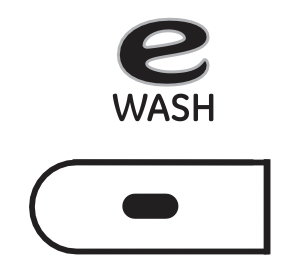
- OVERNIGHT READY (on some models)
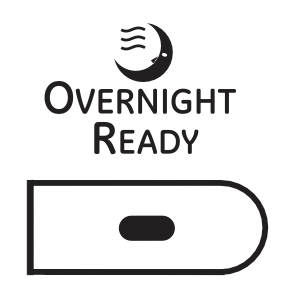
OVERNIGHT READY is intended for smaller loads only. This feature is intended for use when clothes need to be washed and ready to hang or finished the next morning. This feature will tumble clothes and introduce a constant stream of air into the machine compartment upon completion of select wash cycles. Clothes can be removed at any time by pressing pause. To use the feature, press the Overnight Ready button and follow the prompts on the screen. After use, check the lint filter located at the top of the rubber door gasket, cleaning as needed. High wear or delicate articles are not recommended for this cycle.
The table below describes example loads that can be used with this feature:
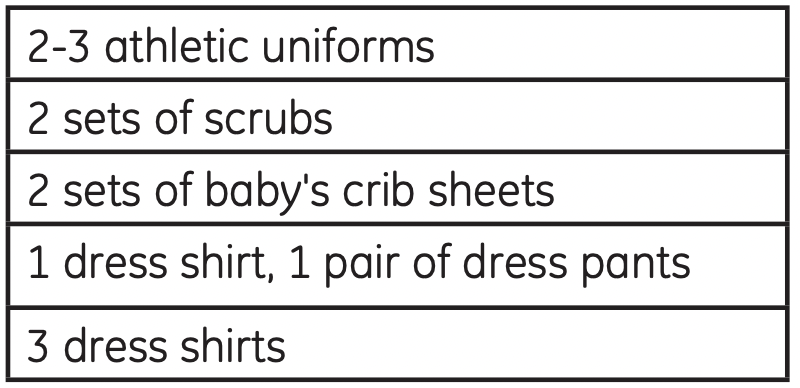
Control settings
CLEANING OVERNIGHT READY LINT FILTER (on some models)
The filter is located in the top right portion of the the washer gasket. For best performance, clean this filter after every Overnight Ready cycle by running your fingers over the filter to remove lint.
For further cleaning, the filter can be removed by pulling forward on the tab.. Replace the filter after cleaning.

About the washer features
The Dispenser Drawer
Slowly open the dispenser drawer by pulling it out until it stops.
After adding laundry products, slowly close the dispenser drawer. Closing the drawer too quickly could result in early dispensing of the bleach, fabric softener or detergent.
You may see water in the bleach and fabric softener compartments at the end of the cycle. This is a result of the flushing/siphoning action and is part of the normal operation of the washer.
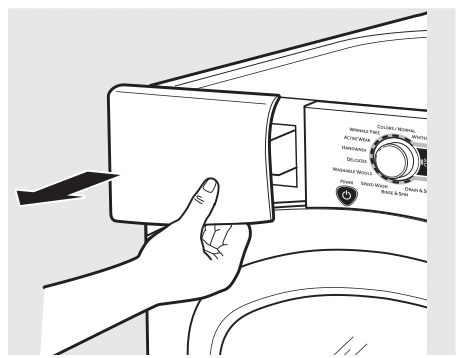
The Prewash Compartment
- Only use the Prewash Compartment if you are selecting the Prewash cycle for heavily soiled clothes. Add measured detergent or prewash additive to the back left prewash compartment of the dispenser drawer.
- Detergent or prewash additive is flushed from the dispenser in the prewash cycle (if selected).
NOTE: Liquid detergent will drain into the washer basket as it is added. - Detergent usage may need to be adjusted for water temperature, water hardness, size and soil level of the load. Avoid using too much detergent in your washer as it can lead to over sudsing and detergent residue being left on the clothes.

The Detergent Compartment
- Only use high-efficiency detergent in this washer. DO NOT fill high-efficiency detergent over the MAX line. Use detergent manufacturer’s recommended amount.
- Powder Detergent – Remove the Detergent selection insert and place it in a safe location outside of the washer. Follow the detergent manufacturer’s instructions when measuring the amount of powder to use.
- Liquid Detergent – Locate the concentration of your detergent on the bottle. Place the Detergent selection insert in the corresponding location depending on the concentration.
- Move the insert by pulling it up and replace it by sliding it down between two detergent compartment rails. Make sure to push the insert to the bottom of the compartment so that it is flush to the bottom of the compartment. It is not an issue if the detergent leaks past the insert to the back of the compartment.
- Detergent usage may need to be adjusted for water temperature, water hardness, size and soil level of the load. Avoid using too much detergent in your washer as it can lead to oversudsing, detergent residue being left on the clothes, and could extend wash times.
- Do not put clumped detergent in the dispenser. Clumped detergent can cause a leak.
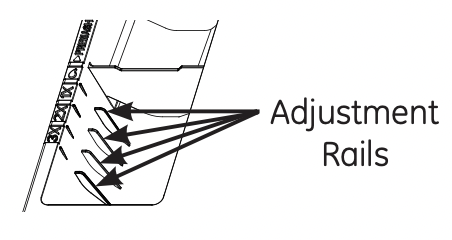
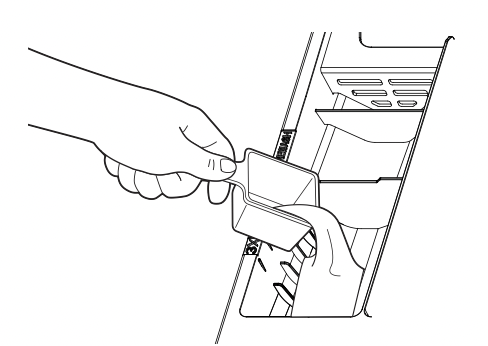
For HE powder detergent remove the Detergent selection insert and add powder here
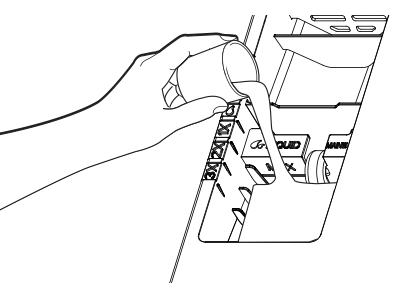
For HE liquid detergent that is nonconcentrated, place the insert in the “1X” position
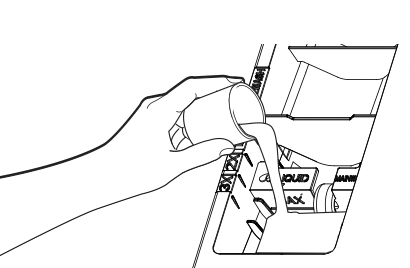
For HE 2X liquid detergent, place the insert in the “2X” position
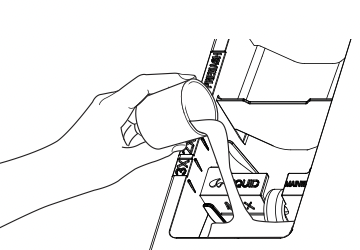
For HE 3X liquid detergent, place the insert in the “3X” position
The Liquid Bleach Compartment
If desired, measure out the recommended amount of liquid bleach, not to exceed 1/3 cup (80 ml) and pour into the center compartment labeled “LIQUID BLEACH” marked with this symbol  .
.
It is recommended to use High-Efficiency (HE) bleach in this front-load washer.
Do not exceed the maximum fill line. Overfilling can cause early dispensing of the bleach which could result in damaged clothes.
NOTE: Do not use powdered bleach in the dispenser.

The Fabric Softener Compartment
If desired, pour the recommended amount of liquid fabric softener into the compartment labeled “FABRIC SOFTENER.”
Use only liquid fabric softener in the dispenser.
Dilute with water to the maximum fill line.
Do not exceed the maximum fill line. Overfilling can cause early dispensing of the fabric softener, which could stain clothes.
NOTE: Do not pour fabric softener directly on the wash load.
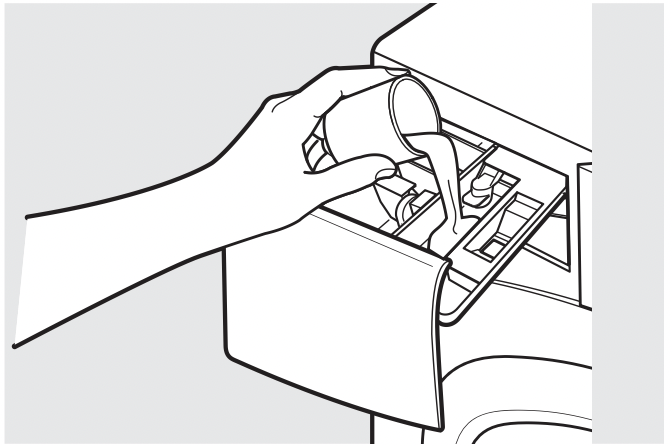
Loading and using the washer
Sorting Wash Loads

- Combine large and small items in a load. Load large items first. Large items should not be more than half the total wash load.
- Washing single items is not recommended. This may cause an out-of-balance load. Add one or two similar items.
- Pillows and comforters should not be mixed with other items. This may cause an out-of-balance load.
- Sort dark-colored clothes from light-colored clothes to prevent dye transfer. This is a high-efficiency washer, so it uses less water, making dye transfer more common.
WARNING - Fire Hazard
- Never place items in the washer that are dampened with gasoline or other flammable liquids.
- No washer can completely remove oil.
- Do not dry anything that has ever had any type of oil on it (including cooking oils).
- Doing so so can result in death, explosion, or fire.
Loading the Washer
The wash drum may be fully loaded with loosely added items. Do not wash garments containing flammable materials (waxes, cleaning fluids, etc.).
To add items after the washer has started, press START/PAUSE and wait until the door is unlatched. The washer may take up to 30 seconds to unlock the door after pressing START/PAUSE, depending on the machine conditions. Do not try to force the door open when it is locked. After the door unlocks, open gently. Add items, close the door and press START/ PAUSE to restart.
Loading Examples*
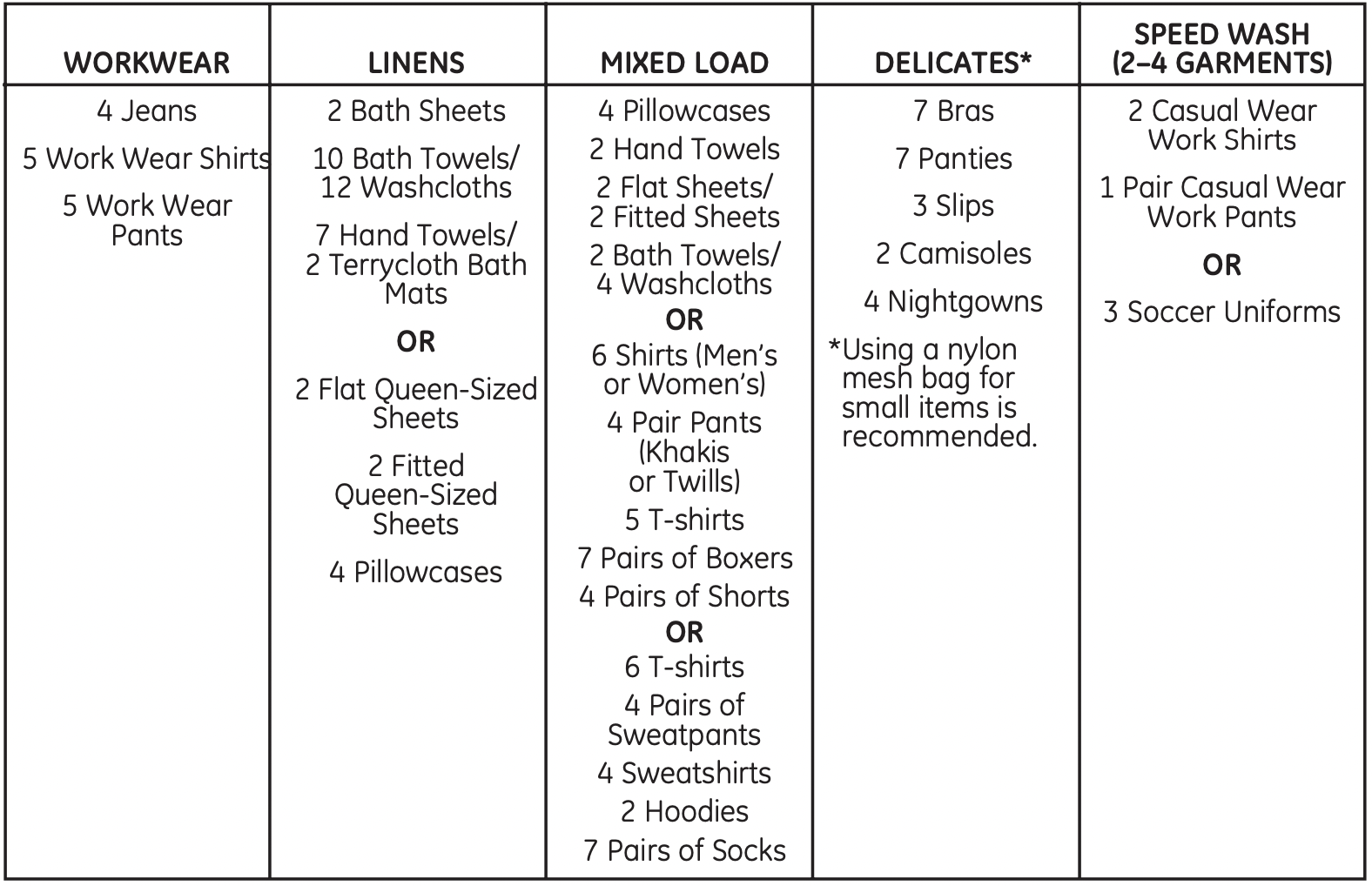
Care and Cleaning
Cleaning the Pump Filter
Due to the nature of the front-load washer, it is sometimes possible for small articles to pass to the pump. The washer has a filter to capture lost items so they are not dumped to the drain. To retrieve lost items, clean out the pump filter.
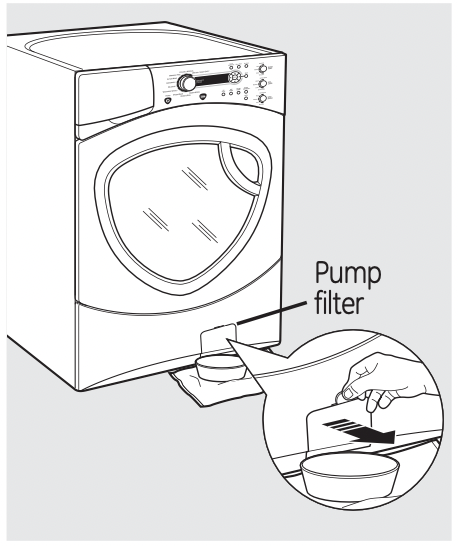
- Using a small flathead screwdriver, open the access door.
- Place a shallow pan or dish under the pump access door and towels on the floor in front of the washer to protect the floor. It is normal to catch about a cup of water when the filter is removed.

- Pull down the pour spout.
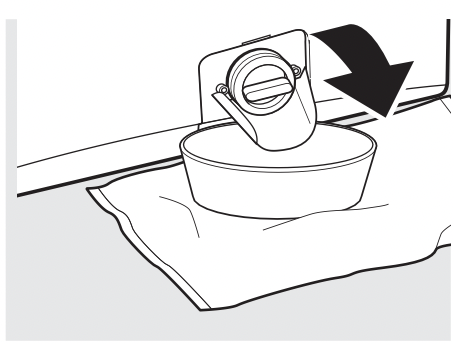
- Turn the pump filter counterclockwise and remove the filter slowly, controlling the flow of the draining water.
- Remove the filter and clean the debris from the filter.
- Replace the filter and turn clockwise.
Tighten securely.
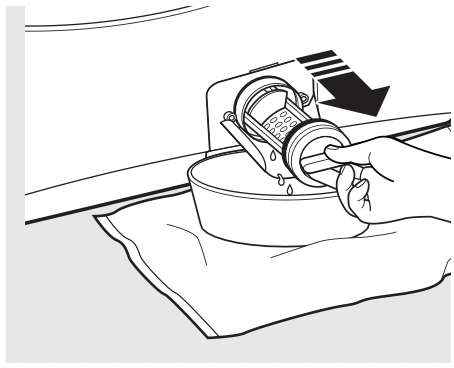
- Flip up the pour spout.
- Close the access door by hooking the bottom tabs first, then rotating the access door shut.

Cleaning the Door Gasket
Open the washer door. Using both hands, press down the door gasket. Remove any foreign objects if found trapped inside the gasket. Make sure there is nothing blocking the holes behind the gasket.
While holding down the door gasket, inspect the interior gasket by pulling it down with your fingers. Remove any foreign objects if found trapped inside this gasket. Make sure there is nothing blocking the holes behind the gasket.
When you are finished cleaning the door gasket, remove your hands and the gaskets will return to the operating position.
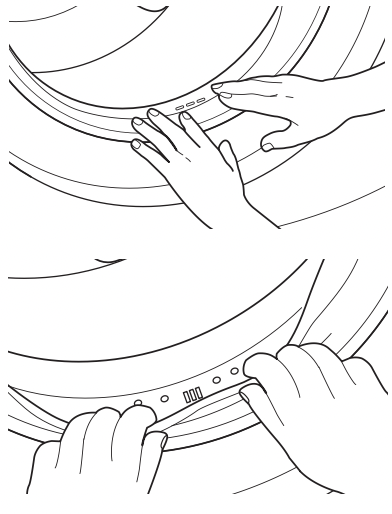
Dispenser Drawer Area: Detergent and fabric softener may build up in the dispenser drawer. Residue should be removed once or twice a month.
- Remove the drawer by first pulling it out until it stops. Then reach back into the right rear corner of the drawer cavity and press down firmly on the lock tab, pulling out the drawer.
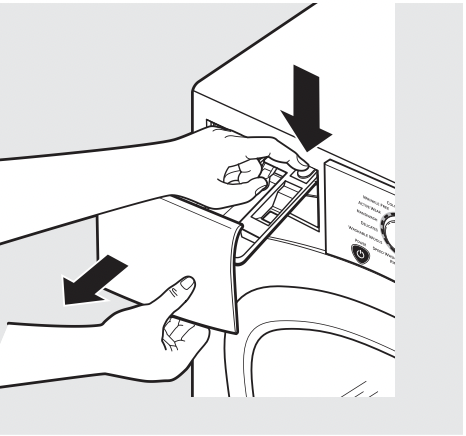
Lock tab is visible only after drawer has been pulled out
- Remove the insert from the bleach and fabric softener compartments and the detergent insert. Rinse the inserts and the drawer with hot water to remove traces of accumulated laundry products.

- To clean the drawer opening, use a small brush to clean the recess. Remove all residue from the upper and lower parts of the recess.
- Return inserts to the proper compartments. Replace the dispenser drawer.

- To reduce buildup in the Dispenser Drawer area:
Use only HE High-Efficiency detergent.

Fabric Care Labels
Below are fabric care label “symbols” that affect the clothing you will be laundering.
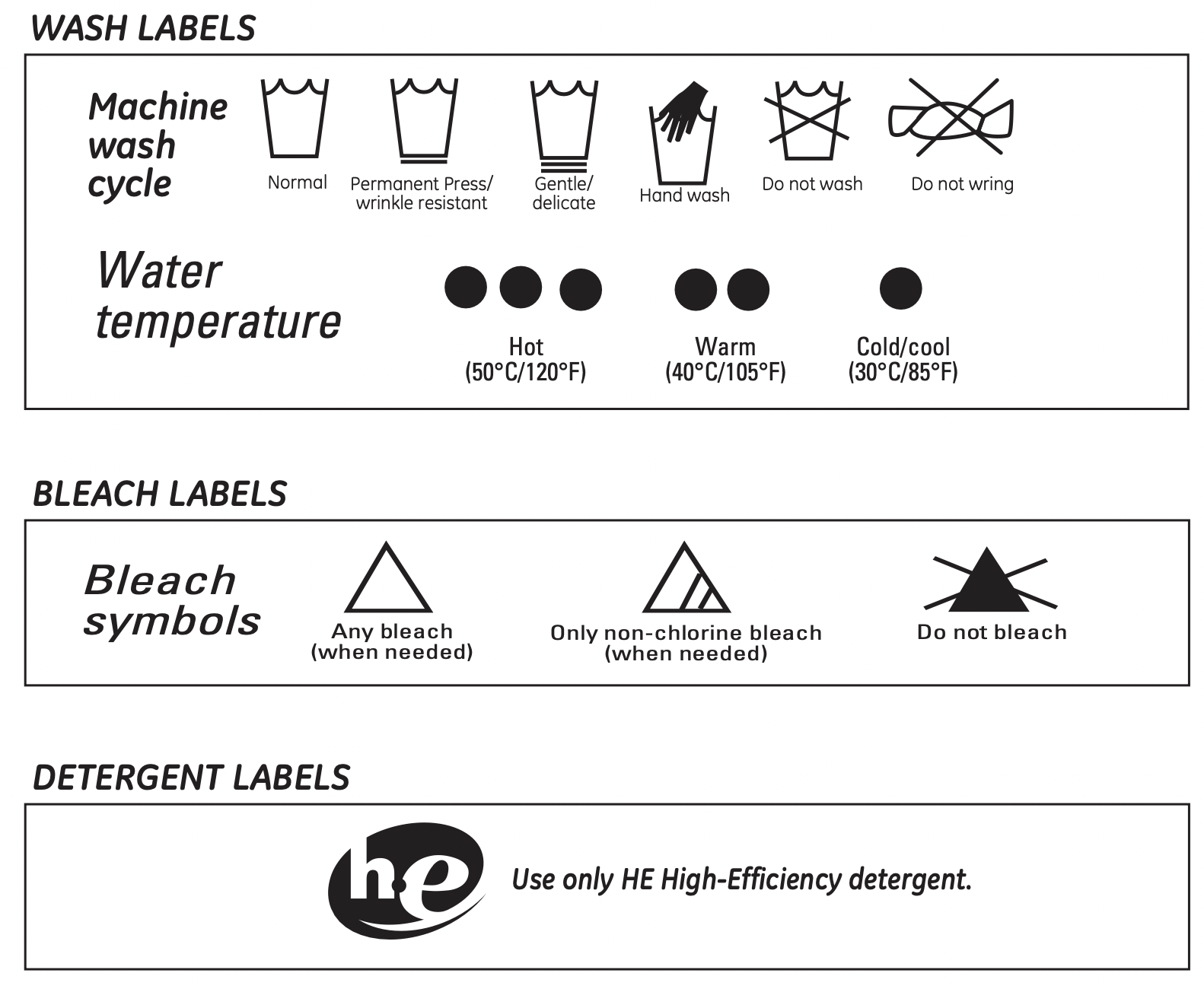
Available accessories
Pedestal
There is a pedestal available for your washer. This pedestal gives the washer more height and gives storage for your washing necessities. Included with the pedestal is a divider that allows you to store liquid laundry detergent out of sight. See the pedestal installation instructions.
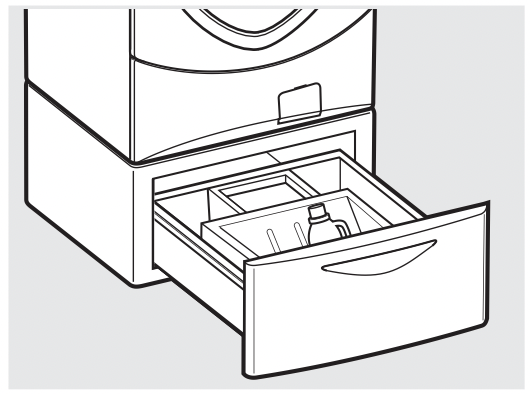
Profile Smart Dispense System
The Profile SMART DISPENSE System lets you store laundry detergent and fabric softener to be dispensed automatically during the wash and rinse cycles of this washer. NO BLEACH may be used in this dispense system. See the Owner‘s Manual that is included with the Profile SMART DISPENSE System for installation instructions.
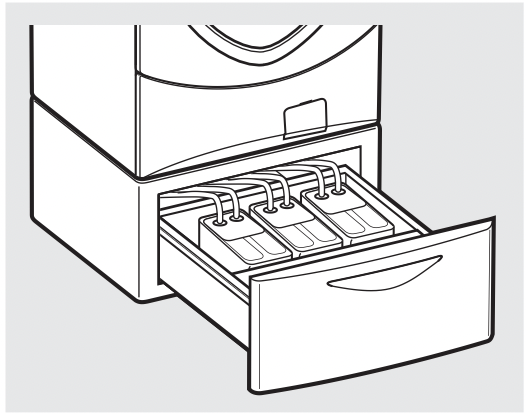
Troubleshooting
|
Problem |
Possible Cause |
What To Do |
|
Not draining Not spinning Not agitating |
Load is out of balance Pump clogged Drain hose is kinked or improperly connected Household drain may be clogged Drain hose siphoning; drainhose pushed too far down the drain |
|
|
Leaking water |
Door gasket is damaged Door gasket not damaged Check back left of washer for water Fill hoses or drain hose is improperly connected Household drain may be clogged Dispenser clogged Incorrect use of detergent Dispenser box crack |
|
|
Clothes too wet |
Load is out of balance Pump clogged Overloading Drain hose is kinked or improperly connected Household drain may be clogged Drain hose siphoning; drain hose pushed too far down the drain |
|
|
Incomplete cycle or timer not advancing |
Automatic load redistribution Pump clogged Drain hose is kinked or improperly connected Household drain may be clogged Drain hose siphoning; drainhose pushed too far down the drain |
|
|
Loud or unusual noise; vibration or shaking |
Cabinet moving All rubber leveling legs are not firmly touching the floor Unbalanced load Pump clogged |
|
|
No power/ washer not working or dead |
Washer is unplugged Water supply is turned off Circuit breaker/fuse is tripped/ blown Automatic self system checks |
|
|
Snags, holes, tears, rips or excessive wear |
Overloaded Pens, pencils, nails, screws or other objects left in pockets Pins, snaps, hooks, sharp buttons, belt buckles, zippers and sharp objects left in pockets |
|
|
Control time wrong or changes |
This is normal |
|
|
Not enough water |
This is normal |
|
|
Washer pauses or has to be restarted, or washer door is locked and will not open |
Pump clogged |
|
|
Door unlocks or press START and machine doesn’t operate |
This is normal Incorrect operation |
|
|
Water does not enter washer or enters slowly |
Automatic self system checks Water supply is turned off Water valve screens are stopped up |
|
|
Wrinkling |
Improper sorting Overloading Incorrect wash cycle Repeated washing in water that is too hot |
|
|
Grayed or yellowed clothes |
Not enough detergent Not using HE (high efficiency) detergent Hard water Water is not hot enough Detergent is not dissolving Dye transfer |
|
|
Colored spots |
Incorrect use of fabric softener Dye transfer |
|
|
Water temperature is incorrect |
Water supply is improperly connected House water heater is not set properly |
|
|
Slight variation in metallic color |
This is normal |
|
|
Bad odor inside your Washer |
Washer unused for a long time, not using recommended quality of HE detergent o rused too much detergent |
|
|
Detergent leak |
Incorrect placement of detergent insert This is normal |
|
|
Improper dispensing of softener or bleach |
Dispenser clogged Softener or bleach is filled above the max line Softener or bleach cap issue |
|
